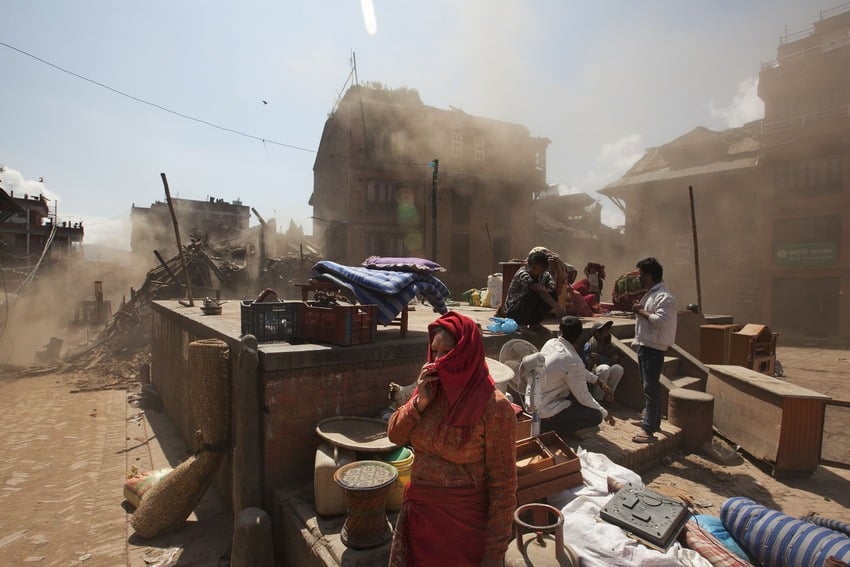With no water supply, no electricity, residents of Kathmandu spent a rainy night in the open before the sun shone on Monday morning. With nearly 100 aftershocks since the 7.9-magnitude earthquake around noon on Saturday – one aftershock measured 6.9 on the Richter scale – hardly anyone dared to sleep inside their cracked houses, and many fled the city.
Even Nepal’s president spent the night in a tent after his official home developed cracks. Rescuers were sleepless anyway, desperately digging beneath the rubble of collapsed homes all over the country’s capital in the light of kerosene lanterns. They found few survivors.
Bhaktapur devastation as seen by drone camera. जता हेर्यो उतै विध्वंस #NepalEarthquake #NepalQuake pic.twitter.com/G4ZKRuDQu2
— salokya (@salokya) April 27, 2015
Nearly two days after the Himalayan quake that jolted Bangladesh, Bhutan, China, India and Pakistan apart from Nepal, landslides still blocked roads to Lamjung – near the epicentre, around 80 km west north west of Kathmandu. Expert climbers and trekkers from the Nepal army had been sent to the area on foot and asked to use village tracks, but little information had trickled back from them. Helicopter sorties showed collapsed houses all around Lamjung and in Gorkha district just south of the area. But ominously, helicopter pilots did not see many survivors waving for rescue or help – usually a common sight after any disaster.
While the quake, aftershocks and rain led to landslides in the middle slopes of the Himalayas, they triggered avalanches at higher altitudes. Estimates of climbers killed on the way to Mount Everest ranged between 20 and 80 – an indication of how many people were still missing, after the initial avalanche nearly wiped out the base camp on the way to the world’s highest peak. Some climbers were rescued by helicopters.
Having occurred at a depth of around 10 km below the earth’s surface, the shallow quake jolted a wide area. Chinese authorities had reported seven deaths on Saturday and updated that figure to 22 on Sunday. And reports were trickling in of a village near the Nepal border having been nearly wiped out.
Huts collapsed in around 100 villages in the Indian states of Bihar and Uttar Pradesh along Nepal’s southern border. The death toll in India crossed 100, plus many landslides reported from Sikkim, the state that lies along Nepal’s eastern border. Sikkim had suffered major damage in an earthquake in 2011. There was serious damage and two deaths in Darjeeling district of West Bengal. Houses in adjacent areas in Bangladesh also developed cracks.
Chaos in Kathmandu
Roads from Kathmandu to the Indian border were completely jammed on Monday as desperate residents tried to flee the city. People spoke of acute drinking water shortage as the municipal water supply had been down since the quake and shops ran out of bottled water. Hospitals reported acute shortage of bandages and medicines and blood, as the injured spilled out into corridors and parking lots.
More images of the pockets of destruction scattered all over Kathmandu #NepalEarthquake pic.twitter.com/pbjynmMUwG — Siobhan Heanue (@siobhanheanue) April 27, 2015
Thousands of tourists – mostly from India – were among those trapped in Kathmandu, a city with a population of 1.2 million. The Indian government has mounted a major relief effort, sending an average of six planeloads of relief material and men each day. The Chinese government has started a similar operation, while Pakistan, Bhutan and Bangladesh have also sent supplies and doctors. The US and Australia are reported to be among countries planning the same.
But from the situation in Kathmandu, it is clear that the relief effort planned will fall far, especially when the damage in the rest of Nepal becomes known.

